WWFF Red Strains:環球魚場紅品種
WR13 Giant Red Turquoise/WR13HF Giant Red Turquoise High Form [Red Royal Blue X WB8 Flach Cobalt]


Above: WB8 Flach Cobalt female, mother of WR13 Giant Red Turquoise
Above: Red Royal Blue, father of WR13 Giant Red Turquoise


Above: WR13 Giant Red Turquoise
Above: WR13 Giant Red Turquoise


Above: WR13 Giant Red Turquoise
Above: WR13 Giant Red Turquoise
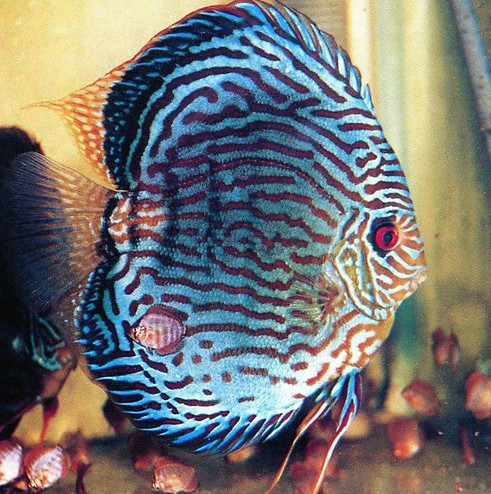

Above: WR13HF Giant Red Turquoise High Form
Above: WR13HF Giant Red Turquoise High Form
In 1986 we found a first class Red Turquoise locally which is most probably a hybrid of RRB and WB7 Red Flash Cobalt. This 16 cm male has a very round body and long, blood red fins. Body color is an attractive deep brownish red. The wide and glittering turquoise blue stripes extend unbroken right to the edge of the dorsal fin and anal fin. Even Dr. Schmidt-Focke was impressed after he had seen its photo.
I selected a nearly solid color female with a round body from the WB8 Flach Cobalt strain to pair with this excellent RRB male. The offspring grow up well. Even at an age of only four months, 25% of them have turquoise stripes on the forehead and the dorsal, anal fins. The other 75% of the brood remains rather drab until 10-12 months old. Those 25% offspring showing early color development become almost solid turquoise discus and the remaining 75% siblings are half to fully striped discus. The F1 generation grows to 16-18 cm at 18-20 months. I utilize the best fully striated fish in every generation to develop the WR13 Giant Red Turquoise strain.
The first two generations of WR13 are really alluring Red Turquoise. The excellent body form and the magnificent finnage are inherited from the male ancestor. The best males attain 18 cm at maturity. They have thick, fluorescent turquoise blue stripes from head to tail inside a deep red body. The well proportioned dorsal fin and anal fin is decorated with a perfectly circular black band, a deep red fringe and many fine, backward slanting turquoise lines. The fully striated females are also exceptional in quality. They grow to 15 cm which is a large size for any female discus. I have never seen such gorgeous finnage in the female sex of any other red strain until now. The ladies also have a vivid turquoise ring on the dorsal and anal fins besides those elaborate embellishments of the gentlemen.
A pair of WR13 was displayed at Turquoise Hall in Taipei City, Taiwan in 1990 with a price tag of NT$800,000, equivalent to approximately USD 30,000. Dr. Lin, a physician from Penang, purchased a pair in 1991 through Mr. Kitano. The pair won the first prize a month later at the Penang Discus Competition.
High body individuals start to appear in the F2 generation. I inbreed them to produce the rare and fascinating second line—WR13HF Giant Red Turquoise High Form. Manfred is very impressed by the variety. He uses them for breeding a few times either in the pure form or in a cross with his red strains. Nevertheless, the high body form only appears in every other generation. This very strange phenomenon also occurs in the progeny of Manfred's "Giant Discus".
WR13 is a very fertile strain. The average brood size is 150 fry. It was our main high quality Red Turquoise strain in production before the mid 1990s and ranks only second in quality to WR7.
Beginning in the F3 generation, the characteristic gray film of the RRB ancestor starts to appear and transforms WR13 into a strain of ugly, gray discus. Reluctantly, I had to terminate breeding at the F4 generation.
The Red Diamonds [WW19LS Red Spotted Green Leopard Skin X Schmidt-Focke Red Turquoise 1st Line]: WR14RS Red Diamond Red Spotted, WR14WS Red Diamond Wide Stripe, WR14Y Golden Nugget


Above: Schmidt-Focke Red Turquoise, father of WR14 Red Diamond
Above: WW19LS Red Spotted Green Leopard Skin, Mother strain of WR14


Above : WR14RS Red Diamond Red Spotted
Above: WR14RS Red Diamond Red Spotted


Above: WR14RS Red Diamond Red Spotted
Above: WR14RS Red Diamond Red Spotted


Above: WR14RS Red Diamond Red Spotted
Above: WR14RS Red Diamond Red Spotted

Above: WR14WS Red Diamond Wide Stripe

Above: WR14WS Red Diamond Wide Stripe

Above: WR14Y Golden Nugget

Above: WR14Y Golden Nugget
The first strain I bred with WW19LS was Schmidt-Focke Red Turquoise. The hybridization took place in September 1989. The female of the pair is the best F1 generation WW19LS which has red eyes and the largest number of red spots. The Schmidt-Focke Red Turquoise male is the one that we purchased in 1986. It is from the 6th or 7th generation of the first line. This inbred male is only 11 cm in length. The orange red body is covered with light greenish turquoise stripes that continue uninterrupted right to the edge of the dorsal, anal fins. This 5-6 years old male gave birth to about 120 young in two broods. Every single fish was kept and grown.
Roughly 75% of the F1 generation has turquoise stripes, a good body form and red color. I divide them into three types to breed separately.
1) WR14RS Red Diamond Red Spotted
These are offspring with red spots and turquoise stripes on a red body but they look different from WW19LS. About 20% of this group are very impressive Red Turquoise having a round body and thick, wavy turquoise stripes. The red spots have fused together to form thin, blood red stripes and short bars in between the turquoise color. The blood red fringe of the dorsal fin and anal fin is decorated with neon blue blotches, short bars and fine, oblique stripes. The long pelvic fins are orange red.
Another 5-6% of WR14RS resembles WW19LS to some degree. Except for the patch of gold on the operculum and abdomen, the whole body and the proximal part of the dorsal, anal fins are solid turquoise. The unique feature is the 3-4 mm diameter irregularly shaped blood red rings and spheres on the periphery of the body and the proximal part of the dorsal, anal fins. The rest of the body is adorned with a lot of blood red specks and short, vertical turquoise stripes.
The Red Turquoise type is larger than the solid turquoise type: 12-14 cm versus 9-10 cm. In the F2 generation, there is a great increase in the percentage of the WW19LS type. The Red Turquoise variety disappears completely in the F3 generation.
2) WR14WS Red Diamond Wide Stripe
The second category is discus possessing wide turquoise stripes. While the father has greenish turquoise stripes and an orange red body, this type has a deep red body. The best specimens have wide, straight, continuous turquoise blue stripes right to the fin edges as well as the golden operculum and abdomen. The dorsal fin , the anal fin and the pair of pelvic fins are blood red.
These are bigger discus than the father strain to reach 13-14 cm when full grown.
3) WR14Y Golden Nugget
There are only very few fishes in this third group. The best specimen is a small, 12 cm, discus with a solid lemon yellow body and long, graceful fins. The minute red spots are restricted mainly to the dorsal 2/3 of the 4th and 5th vertical bar that stand out extremely well from the lemon yellow body.
I was not able to breed the one-of-a-kind lemon yellow discus. Similar looking discus never appears again in all the later generations.
Although they are bigger than both the parental strains, the Red Diamonds are still small discus. The maximum length is 14 cm for males and 11 cm for females. Roughly 60% of WR14 has red eyes.
Despite being a hybrid, they are still rather difficult to breed. Only the F1 generation has good fecundity. The effects of inbreeding occur as early as in the F2 generation to result in a reduction in fertility and size. The F3 generation females average only 8 cm in length.
WR15 Heckel Red Turquoise [Red Royal Blue X WB7 Red Flash Cobalt


Above: WR15 Heckel Red Turquoise without Heckel Bar
Above: WR15 Heckel Red Turquoise

Above: Hong Kong bred Red Royal Blue, father of WR15 Heckel Red Turquoise
In late 1986 Rocky and I saw a special RRB with a very strong Heckel Bar in a Mr. Shek' home. It has an almost solid turquoise body and a very round body form. Since all solid color RRB are oval discus, the fish is a rare specimen. Our good friend told us he bred this large, 17 cm male from RRB. I was interested to study the inheritance of Heckel Bar and so by an exchange of discus, we obtained this discus from our friend.
I mated this male with a WB7 Red Flash Cobalt female. Color appears very early in the offspring. At an early age of five months, they already have many turquoise stripes and blood red fins. These round body offspring grow to a length of 15-16 cm. Most are fantastic Red Turquoise at maturity (18-20 months). They have wide and fluorescent turquoise blue stripes on the whole body and gorgeous finnage. Body color is deep red and over 60% of them have red eyes. The high dorsal, anal fins are decorated with a narrow black loop, a deep red rim and dozens of fine, oblique, neon blue streaks. The pelvic fins are orange red.
The Heckel Bar appears at an age of 15 months in less than 2% of the F1 generation. It is not as wide and dark as the RRB father and the 6th and 7th bars are also accentuated. I gave them the name WR15 Heckel Red Turquoise.
To my great disappointment, the Heckel Bar disappears completely in the F2 generation, consequently, I made no attempt to breed a F3 generation.
WR16 High Body Red Turquoise

Above: WR16 High Body Red Turquoise

Above: WR16 High Body Red Turquoise

Above: WR16 High Body Red Turquoise
WR16 High Body Red Turquoise
We obtained Red Turquoise from Manfred Göbel as early as in 1987. All his discus have genes from a group of big discus that is said to originate from Jack Wattley in the early 1980s. Hybrids of these big discus grow to a length of 20 cm or more.
I saw a pair of first class high body Red Turquoise in Manfred's hatchery during my visit to Germany in 1990. He was very gracious to send it as a gift soon after I had returned to Hong Kong. While the parents still have a notch above the nostrils and a concave throat ("Giant Discus Traits"), however, the offspring are superb high body Red Turquoise with a smooth body contour and attain 18 cm when full grown. They have blood red eyes and are fully striated with glittering 5-6 mm wide turquoise stripes on a brownish red body. I named them WR16 High Body Red Turquoise.
WR16 was a big hit when released into the market. It was the only high body and big size discus that was available in the early 1990s. The difference in size between the 12-13 cm German Red Turquoise and the 18 cm WR16 is like David and Goliath. The strain was very well received by the Japanese hobbyists for more than 10 years and only to be replaced in the early 2000 by better strains such as WR36 Red Peony, WR62 Zebra Red Turquoise and WR63 Red Hercules.
WR17 Red Pearl Discus

Above: WR17 Red Pearl
Dr. Schmidt-Focke carried out a series of test crosses to produce Pearl Discus in the early 1980s. The first was in 1983. He hybridized a male of his first line Red Turquoise strain with a female High Fin Powder Blue, a high fin brown fish that only have a few pale turquoise stripes on the dorsal and anal fins. The offspring are Brown Discus and a few Pearl Discus. The body color is a mixture of brown and red. We obtained a batch of youngsters from a remake of the cross later in the year from the doctor. They also grow up to be mostly half striated discus. Very few are Pearl Discus.
The doctor mated his F1 generation Red Pearl discus with a wild Royal Blue in 1984. He sent us some offspring. They mature as beautiful discus with an orange red body but they are mostly half striped discus. I was able to obtain a gorgeous Red Pearl Discus and a handsome high fin Red Turquoise female from this group.
From another German breeder we obtained youngsters from a wild Royal Blue crossed to a Schmidt-Focke Red Pearl in 1984. They mature as graceful discus with red eyes and blood red fins. There are about 20% fully striated specimens but no Pearl Discus. The unique feature of this batch is the rows of tiny carmine dots in between the turquoise stripes.
In 1987 the doctor sent us a batch of 4 cm youngstersa from a friend. The female is a fish from the first line of his Red Turquoise strain. The male is a very red wild Royal Blue. At a year of age, more than half of the 20 fishes only have turquoise stripes at the anterior part of the body. There are also a few Pearl Discus, some fully striated Red Turquoise and two Blue Turquoise inside the group.
It can be seen from the above hybridization results that very few Pearl Discus can be bred by crossing striped discus with nonstriated discus (fish similar to a Brown Discus). I had no success to create a true breeding strain even by inbreeding all our Pearl Discus since they became 2/3 striped to fully striated discus in the F2 or F3 generations.
WW18 Wild Royal Blue F1 [S. haraldi Schultz, 1960: phenotype blue]
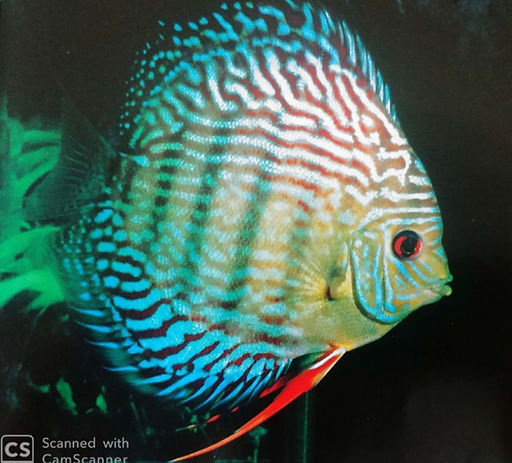

Above: WW18 Rio Manacapuru Royal Blue F2
Above: F1 Green Striped Wild Discus F1
We never have the true Royal Blue from the Rio Purus and Manacapuru regions.
Jorg Schutz sent us via Manfred some Rio Manacapuru Royal Blue F1 generation offspring. We were able to breed a few F2 offspring. I crossed one with a Red Pearl to produce WR28 Tangerine Pearl.
In 1985 Dr. Schmidt-Focke sent us some young discus from a pair of green striped wild discus. Most of them grow up having no turquoise stripes on the body, a few have half body stripes but there is an exceptional fish possessing wide and iridescent greenish turquoise stripes from head to tail which extend into the dorsal fin and anal fin. Both fins are deep red in color and are ornamented with many fine and short turquoise lines. Other unique features of the fish are the golden abdomen and red spots. I tried to breed them for years but failed. It is unfortunate because I had never seen a similar type again in the later years.
WW19 Red Spotted Green Complex: WW19LS Red Spotted Green Leopard Skin (1st Line); WR19 Red Spotted Green (2nd Line); WW19N New Red Spotted Green or 1/2WW19LS 1/2 Red Spotted Green Leopard Skin (3rd Line); 3/4WW19LS 3/4 Red Spotted Green Leopard Skin (4th Line)

Above: WW19LS Red Spotted Green Leopard Skin

Above: WW19LS Red Spotted Green Leopard Skin with Hekel Bar
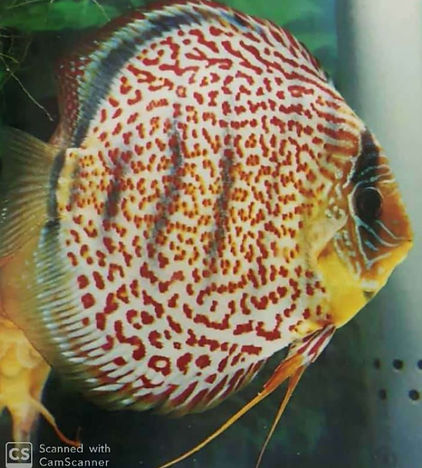
Above: WW19LS Red Spotted Green Leopard Skin

Above: WW19LS Red Spotted Green Leopard Skin


Above: WW19LS Red Spotted Green Leopard Skin
Above: WW19LS Red Spotted Green Leopard Skin

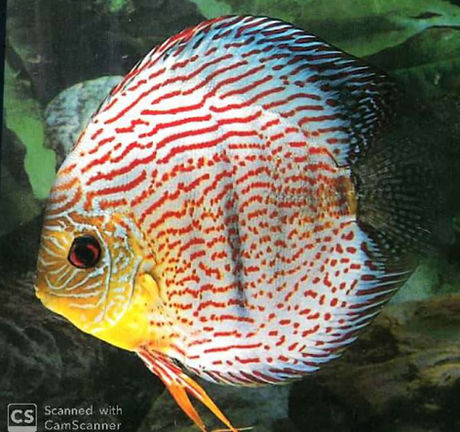
Above: WW19LS Red Spotted Green Leopard Skin
Above: WW19LS Red Spotted Green Leopard Skin F3

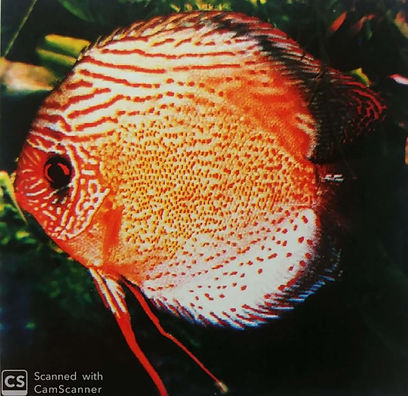
Above: WW19LS Red Spotted Green Leopard Skin
Above: WW19LS Red Spotted Green Leopard Skin F4
photo courtesy of Mr. Jörg Schütz , Germany

Above: WR19 Red Spotted Green F2

Above: WR19 Red Spotted Green F2
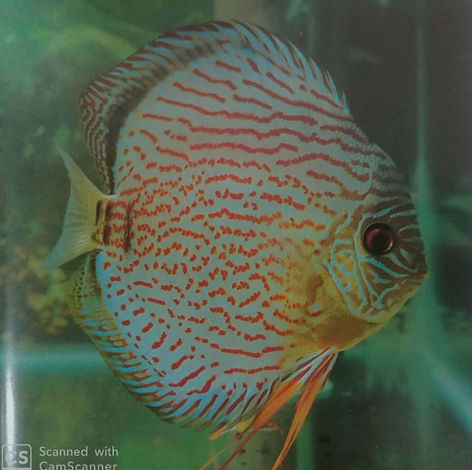

Above: WR19N Red Spotted Green New
Above: WW19N Red Spotted Green New

Above:3/4WW19LS 3/4 Red Spotted Green Leopard Skin
WW19LS Red Spotted Green Leopard Skin (1st Line)
Dr. Schmidt-Focke found some two first class Red Spotted Green in a pet shop in Bad Homburg in the summer of 1985. Although they were in a very bad condition and were likely to die, the doctor purchased them. After more than a year of the best care they bred but the males was found to be sterile. Dr. Schmidt-Focke substituted with another male of an inferior quality and was able to produce a brood of about 60 youngs.
The doctor kept eight for himself, sent us 20 and sold the rest of the brood together with their parents.
When the batch is about four months old, the first trace of red spots start to appear on the body which become clearly visible two months later. Half of them have numerous, minute red spots and an intricate network of fine turquoise stripes on the whole fish at 16-18 months of age. The other 10 discus are quarter to half striped fish with less red spots. Some of these 1/4-1/2 striated fish also have a greenish film on the whole body. Most of the fishes have yellow eyes.
I named this strain WW19LS Red Spotted Green Leopard Skin. The term Leopard Skin refers specifically to the unique pattern of numerous one scale size red spots inside a network of fine, reticulated turquoise stripes that resembles the skin pattern of a leopard, Panthera pardus.
The F1 generation WW19LS is rather small and attains a length of only 11-12 cm. They are by no means easy to breed. Only a single male is fertile. We are able to breed several small broods adding up to about 100 offspring.
In the F2 generation, also about 50% is good quality fish which has a slightly refined version of the Leopard Skin pattern and longer finnage. There is a variation in the body color from an appealing light brown to shades of reddish brown. The other half is fish of lesser quality that only has turquoise striped on half of the body and some red spots. Traces of the Heckel Bar start to appear in this generation.
The best fishes are produced in the F3 generation which contains almost 100% Leopard Skin specimens. They are small discus reaching only 12-13 cm when fully grown. A few of the males have a short streamer on the dorsal fin. The body color is an elegant light brown. There is also that patch of golden (yellowish brown) color on the abdomen to augment its attractiveness.
While the fins grow longer in each generation and the prominent black band on the dorsal and anal fin become narrower and less dark as inbreeding proceeds, WW19LS has retained all the exquisite Green Discus traits even in the F5 inbred generation. They have the same smooth contoured oval body form, the delightful light brown body color, the attractive golden abdomen and the deep red rim on the dorsal, anal fins but without the ugly cephalic hump. In other words, WW19LS is the ultimate refined version of Green Discus, S. tarzoo Lyons, 1959. However, at least 75% of the F5 generation of this strain still has yellow eyes.
WW19LS is extremely difficult to breed. During the 15 years of the strain's existence, we were able to breed only a few hundred first line specimens. The strain takes more than two years to mature. Mating begins at around 21/2 years after birth but the usual courtship behaviors are missing. The only sign of two fishes pairing off is they stay closely together momentarily in the community tank. Females do not lay eggs until nearly three years old and the number of eggs is always small. As inbreeding proceeds, females of the F4 and F5 generations are mostly sterile. Those that can breed lay a few eggs only once or twice at the very old age of four to five years.
Male fertility is also very low. The average brood size is 20-30 fry. A brood of 50 larvae is large. The larvae are so weak that they can only be raised artificially beginning at the F2 generation but even so, the survival rate is always less than 50%.
WR19 Red Spotted Green (2nd Line)
In early 1990 I selected the best Royal Green male that has very wide turquoise stripes from the 1988 Green Discus batch from Japan to breed with a F1 generation WW19LS female. Their progeny are the rare WR19 Red Spotted Green which existed for only a few years in the early 1990s.
The F1 generation starts to develop red spots at around 51/2 months of age. They attained a length of 15 cm when two years old and are more robust and thicker than the pure WW19LS. Although the body form is a bit rounder than the Green Discus father, some of them have a cephalic hump. Roughly 70% of them have red spots but they are 2-3 times larger and the color is darker than the pure WW19LS. About half of them have narrow, wavy turquoise stripes all over the body. Nevertheless, none of the siblings have the Leopard Skin pattern. The best specimens, about 30% of each brood, have 3-4 mm wide, wavy turquoise stripes at the dorsal part of the body and part of the dorsal fin. The center of the body, the abdomen and the anal fin are all solid turquoise. In between the turquoise color are spheres, blotches and narrow, wavy stripes of red. These F1 generation specimens have a rather thick black band in the middle of the dorsal and anal fin.
I inbreed the best specimens. Nearly 50% of the F2 generation resemble the best F1 generation very closely to have the same turquoise stripes and patches as well as many red spots, however, the black band on the dorsal and anal fins that is so prominent in the Green Discus father is present in a more narrow form only on the dorsal fin.
A few of the F2 generation WR19 are similar to WR14Y Golden Nugget. These magnificent specimens have a yellowish brown, almost golden body and many vivid, one scale size red spots. Turquoise stripes are restricted mainly to the periphery of the fish, e.g., head, operculum, and fins (dorsal, anal, pelvic). Only some short, narrow and wavy stripes are found on the body. The alluring light brown body is contrasted very well by a wide black loop in the middle of the long dorsal and anal fin which are ornamented on the inside with a complete ring of turquoise blue. Both fins have a deep red fringe inside which are many narrow, oblique turquoise lines. The pelvic fins are orange red. All these jewels on the finnage add a lot to the attractiveness of these rare and precious discus.
WW19N New Red Spotted Green or 1/2WW19LS 1/2 Red Spotted Green Leopard Skin (3rd Line)
In early 1995 l mated the best F2 generation WW19LS male with an exceptional Tefé Green female that we purchased from Manaus in the previous year. The female has a light brown body, strong turquoise stripes, numerous red spots and the golden abdomen, which is a better fish than the female ancestor of WW19LS. This third line, WW19N or 1/2WW19LS looks very similar to WR19 to have wider turquoise stripes, larger red spots and shorter fins than the WW19LS father. They also attain a bigger size of 13-15 cm when full grown. There is a touch of its Green Discus heritage in WW19N but the Leopard Skin pattern is lost.
I repeated the same hybridization with several other excellent wild Green Discus in the following years right up to the relocation of our farm to Taiwan in March, 1997. The results of all these crossings are very similar.
3/4WW19LS 3/4 Red Spotted Green Leopard Skin (4th line)
The first endeavor to produce the fourth line, 3/4WW19LS, was made in 1992 by the use of a F2 generation WW19LS and the best fish from the F1 generation WR19. The offspring grow faster to reach a maximum length of 14 cm. Only a few specimens in a brood resemble WW19LS to some degree together with more Green Discus influence, a thicker body and a cephalic hump specifically.
In 1996 there was a rapid deterioration of vigor and fertility in the F3 generation of WW19LS. To save the strain, I hybridize the best specimens of F1 generation WW19N with F3 generation WW19LS to produce the 4th line—3/4WW19LS. It is a more robust fish than WW19LS to attain 13-14 cm at maturity. There are about 10% siblings in a brood which resemble the pure WW19LS rather closely and the other 90% discus are similar to WR19N. In the F2 generation, depending on the parents, the percentage of fish with the Leopard Skin pattern is increased to 20-25%.
Both WW19N and 3/4WW19LS are much stronger and easier to breed than the pure WW19LS. They also mature earlier and pairing begins at 20-22 month. 95% of the WW19 complex that we manage to breed during all the years are these two varieties.
WW20 Alenquer Solid Red [S. aequifasciatus Pellegrin, 1904: phenotype brown ]


Above: WW20 Alenquer Solid Red
Above: Mother of WR25 & WW20, doctor's fish
In 1992 Manfred sent us several Alenquer Discus he had purchased from Mr. Werner a few weeks ago.
I hybridized the same mother fish of WR25 with a wild Alenquer Discus to produce our WW20 strain in 1992. They have a nice body form for a solid red strain and no Heckel Bar. The pointed mouth of the Alenquer Discus father is inherited but it is not as ugly as the wild parent. There is a thick black stripe in the middle of the dorsal fin and anal fin which is ornamented with an incomplete ring of turquoise on the inside. The orange red body color is deeper than both the mother and Jörg's WW69 Millennium Red. The redder females only have turquoise stripes on the head, the operculum and fins. Males are 1/3-1/2 striated. WW20 reaches 13-14 cm at maturity.
WR 25 The Tangerine Dreams: WR25WS Tangerine Dream Wide Stripe, WR25RS Tangerine Dream Red Spotted, WR25SR Tangerine Dream Solid Red

Above: WR25RS The 18 months old Tangerine Dream Red Spotted femasle


Above: Same fish as above when 21/2 years old. All the red spots had disappear.
Above: WR25WS Tangerine Dream Wide Stripe


Above: WR25WS Tangerine Dream Wide Stripe
Above: WR25WS Tangerine Dream Wide Stripe


Above: WR25SR Tangerine Dream Solid Red
Above: WR25SR Tangerine Dream Solid Red


Above: WR25SR Tangerine Dream Solid Red
Above: WR25SR Tangerine Dream Solid Red

Above: WR25SR Tangerine Dream Solid Red bred by Manfred Göbel, photo courtesy of Mr. Manfred Göbel,
Germany

Above: (Left) WR25SR Tangerine Dream Solid Red (Right) Tangerine Dream Wide Stripe WR25WS
In July 1990 we obtained two half size Red Discus from Dr. Schmidt-Focke during our visit to Germany. When I asked the doctor what they were, he only told me the two red fishes were Red Discus.
The two Red Discus grow up well to attain a length of 12-13 cm. Both fishes have an orange red body and no trace of the Heckel Bar. The turquoise stripes are restricted to the anterior part of the body and on the dorsal, anal fins and the pair of pelvic fins. They are not the elongated, turquoise striped Red Eddie yet look instead very similar to Jörg Schütz's Cuipéua Discus (WW69 Millennium Red). These two fishes from the doctor are most probably also Cuipéua Discus or Cuipéua Discus X Alenquer Discus.
In early 1991 I chose the smaller and redder one of the two fishes (both are females) to breed with the only fertile F1 generation WW19LS male.
The offspring mature as 13-15 cm discus. Most of them are orange red fish like the mother. About 75% of the siblings have red eyes. I divide the F1 generation into three groups to breed separately.
1) WR25WS Tangerine Dream Wild Stripe
This type makes up about 10% of the brood. Most of them have linear turquoise stripes on half of the body and some red spots in between the stripes. A few are superb Red Turquoise having full body striation and long, blood red fins. Although fully striated with thick turquoise stripes, they still show resemblances to their W19LS ancestor to have the same smooth contour body form, the light brown body color, the golden abdomen, the small specks of turquoise color on the anal fin and many red spots.
2) WR25RS Tangerine Dream Red Spotted
There are two fishes (a pair) inside this category which are the most beautiful discus I have ever created. The female has vivid, fluorescent turquoise stripes on the back and the proximal half of the dorsal fin. The spaces in between the turquoise stripes are deep red. The black strap in the middle of the long dorsal and anal fins are embellished on the inside with a near complete ring of turquoise and overlain with a translucent, glittering turquoise blue haze. The deep red rim of both fins are adorned with fine turquoise lines. In the middle of the body are several indistinct, wavy and broken turquoise stripes. The most attractive feature of the fish is the linear rows of one scale size, bright red spots in between the vague turquoise patterns. The ventral part of the body is an exquisite golden yellow color. It is embellished with six board, wavy turquoise stripes terminating at the black loop on the anal fin. The last jewels of the fish are the pair of bright orange red pelvic fins and blood red eyes. All these alluring features add up to enhance the charm, the grace and the exclusiveness of this fantastic discus.
The red eyed male has almost the same color pattern as the female. The longer dorsal fin has a narrow deep red fringe and a streamer on its end. There is no black band in its middle. In its position are short, fluorescent and backward slanting turquoise bars. The distal part of the anal fin has a similar color pattern as the dorsal fin but without the red rim. There are wide turquoise stripes on the dorsal and ventral part of the body going uninterrupted to the middle of the dorsal and anal fin. In between the turquoise color on the periphery of the fish are narrow blood red stripes. The part of the body below the lateral line has the same golden yellow basic body color like the female. There are also several vague, wavy turquoise stripes and short bars in the middle of the body. However, the red spots in this area are not in neat rows and some have even fused into short, wavy lines.
3) WR25SR Tangerine Dream Solid Red
The remaining 90% of the F1 generation offspring are solid red fishes with a few turquoise stripes on the head and fins. The red color is almost as intense as WR38 that has a very attractive orange tint. Some of them have a few red spots.
Tangerine Dream, famous as it is, is a short lived strain with poor breeding results.
The red color of the only pair of WR25RS develops further to conceal the red spots and the turquoise stripes. They are transformed eventually into solid red discus at about 30 months of age. It is a really strange phenomenon that I have never seen in any other strains. This pair does not breed true. All the offspring are half striped discus with few red spots.
WR25WS is more reliable in breeding. Most of the offspring have turquoise stripes on at least half of the body. The best specimen of this group is a magnificent discus from the F2 generation with long fins and a triangular extension on the end of the dorsal fin. It has thick, parallel, continuous turquoise stripes extending from head to tail all over the body to terminate uninterrupted at the edge of the dorsal fin and these stripes also converge into solid patches on the anal fin. The stripes are so uniform, linear and vivid that they appear to be drawn on the fish's body by an accomplished painter.
In 1998 Mr. Hirose Irie won the grand champion at the International Discus Championship in Duisburg, Germany with a WR25WS bred by Manfred Göbel.
Offspring of WR25SR are half striped discus instead of solid red fish.
WR26 Tropical Sunset [WW19LS Red Spotted Green Leopard Skin X WR13 Giant Red Turquoise]


Above: WR26 Tropical Sunset
Above: WR26 Tropical Sunset
The hybridisation took place in 1990. In this cross, the male is a first class F2 generation WR13 which has excellent wide and straight turquoise blue stripes inside a nicely shaped, brownish red body. The female WW19LS is a good quality F1 generation fish.
The well-rounded offspring look like Brown Discus until eight months old. Red spots and turquoise striation develop very slowly afterwards. At 18-22 months, about 40% of the F1 generation resembles the father rather closely but with the bonus of red spots. The remaining 60% siblings are an assortment of inferior quality 1/4-1/2 striped discus having no red spots..
The F2 generation matures as very handsome, 13-15 cm specimens. The best fishes have inherited the classy light brown body color and the exquisite golden abdomen from the WW19LS ancestor. There are wide turquoise blue stripes on the whole body. In between the turquoise stripes are narrow rows of fused deep red spots. The high dorsal fin and anal fin is adorned with a thick black band in the middle, a deep red fringe and many fine, slanted neon blue lines. There is a mixture of yellow and red eyed fish in this strain.
In view of their beautiful combination of colors, such as blue, green, red and especially the patch of gold on the abdomen, I named the strain WR26 Tropical Sunset.
The gray film that is common to all RRB hybrids also starts to appear in the F3 generation of WR26. It eventually covers up the turquoise stripes, red spots and the golden throat to bring an end to this beautiful strain.
WR27 Pink Fairy
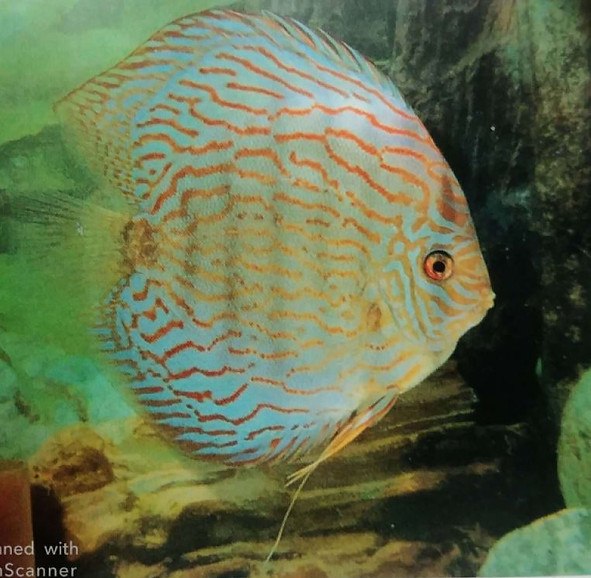

Above: WR27 Pink Fairy
Above: WR27 Pink Fairy
Dr. Schmidt-Focke sent us a group of near adult size, 12-13 cm, Red Turquoise bred by a friend in 1985 who most probably is Hubert Kleijker. These high fin discus have a perfectly round body and are fully striated with wide, greenish turquoise stripes from head to tail. About 25% of them have a pinkish body, a feature even rarer than Snakeskin. I bred one of the pink females with a Red Turquoise male from Manfred to develop the WR27 Pink Fairy strain.
About 25% of the F1 generation has inherited the very rare pink body from the mother strain. The remaining siblings have a very charming light brown body. All the offspring are also extremely round in body form and the same excellent turquoise green stripes of the mother. Their dorsal fin and anal fin is much longer than the parents which is embellished with a deep red fringe. This strain grows to a very good size of 14-16 cm. Most of them have blood red eyes.
There are no more pink specimens in the F2 generation but a female Snakeskin Discus appears. This fish is always black and timid. It grows slower than the rest of the brood and the stripes develop very late, beginning at the age of two years. It spawns twice but lays dead eggs. A half Snakeskin specimen also appears in the F3 generation. This fish is most probably congenitally sterile because it never shows any interest in breeding.
WR 18S Rio Manacapurur Red Flash Cobalt

Above: WR28 Tangerine Pearl, photo courtesy of Mr. Masahiro Kariba, Japan
Jörg Schütz sent to us a few small offspring from a pair of Rio Manacapuru Royal Blue in 1987 through Manfred. They mature as fully striated discus with a brown body and brilliant turquoise blue stripes. The body form is round but there is a notch just above the nostrils and a concave throat. We were able to breed a few offspring.
In around 1990 I bred a F2 generation fish with WR17 in an effort to produce Pearl Discus. The offspring are mainly half striped discus which have a nice body form and beautiful long fins. To my surprise, some fishes of the brood show a strong resemblance to the Rio Manacapuru Royal Blue parent to have the same narrow and iridescent bluish turquoise stripes and a deep chocolate body. I called them WR18S Manacapuru Red Flash Cobalt with reference to the iridescent blue stripes and the reddish brown body.
WR28 Tangerine Pearl
My first effort to create Pearl Discus has led to the creation of WR18S. This strain is produced by the continuation of such an effort. I inbreed the best half striated WR18S specimens to produce some pretty Red Pearl Discus having short turquoise bars in addition to the spheres. Their body color is a light tangerine. The best fishes also have that elegant golden abdomen and red eyes, consequently, I named the strain WR28 Tangerine Pearl. To the contrary of my goal, the biggest males are excellent Red Turquoise with wide and wavy turquoise blue stripes all over the body. They have inherited the round body form but also the notch above the nostrils and the concave throat from the Rio Manacapuru Royal Blue ancestor.
WR28S [WR25SR Tangerine Dream Solid Red X WR14RS Red Diamond Red Spotted]

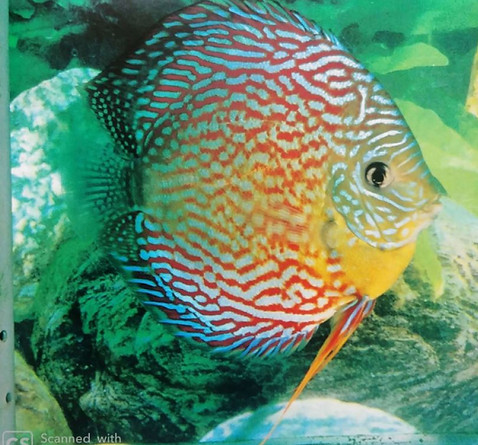
Above: WR28S Super Tangerine Pearl female
Above: WR28S Super Tangerine Pearl male
WR28S has no relation with WR28. It is a cross of WR25SR with WR14RS. The best males have a round body form, high fins, the patch of gold on the abdomen and long, orange red pelvic fins. Their most fascinating feature is the two-toned body that gradually changes from a deep red on the back and the abdomen into a yellowish brown in the middle of the body. This big central blotch is embellished with many neatly arranged spheres and short bars of turquoise. The deep red dorsal fin and anal fin does not have a black ring. To complete the complex color design of these fabulous discus, the periphery of the body and the dorsal, anal fins are decorated with many backward slanting, neon blue stripes.
The best females are equally impressive. They have the same golden abdomen of the male sex. The exquisite light brown body is decorated with many turquoise spheres and wavy stripes.
WR28S is my most successful endeavor to produce Pearl Discus. Most of them have red eyes and grow to 13-15 cm at maturity. However, the pearl trait was still impossible to fix by inbreeding.
WR29 High Body Red Diamond/WR29 High Body Red Diamond, Blue Form [WR14RS Red Diamond Red Spotted X WR16 High Body Red Turquoise]

Above: WR29 High Body Red Diamond

Above: WR29 High Body Red Diamond

Above: WR29BF High Body Red Diamond Blue Form
WR29 High Body Red Diamond is WR16 hybridized with WR14RS. The WR14RS parent is exceptionally large , 14 cm long fish looking a lot like WW19LS.
WR29 was a very popular strain when introduced into the market in the early 1990s. It was the first high body red spotted strain in the world to have thick turquoise stripes and a big size of 15-17 cm. The broad stripes can be continuous and straight or wavy and broken. Red spots are found in between the stripes but they are not as red and vivid as WR14RS. Body color is a charming light brown. Some specimens also have the graceful golden patch on the abdomen and most of them have blood red eyes.
There are some fishes with a very fascinating solid turquoise body in the F2 generation. The turquoise color looks like a very delicate light blue haze on the whole body. Its intensity keeps changing when the fish swims around in the aquarium. Other jewels of the fish are the red spots, the perfectly round body and the deep red fringe of the dorsal and anal fins. I named them WR29BF High Body Red Turquoise Blue Form. Like many other idiosyncratic discus, it was impossible to stabilize WB29BF by inbreeding and selection.
WR31 High Body Rio Ica Red


Above: WR31 High Body Rio Ica Red
Above: WR31 High Body Rio Ica Red

�
Above: WR31 High Body Rio Ica Red from 2nd Male
Dr. Schmidt-Focke had a few reddish brown discus with a Heckel Bar in 1986-'88. They were initially identified as Rio Içana Discus by Heiko Bleher but the name was changed to Rio Içá Discus a few months later.
The doctor had no success in breeding them. Manfred was able to obtain a not so good brown female with a weak Heckel Bar by an exchange of discus with the doctor. He mated it with a high body Red Turquoise and also with an orange fish that only has a few turquoise stripes on the fins. Manfred sent to us twenty offspring from both crosses in around 1988.
The cross with the high body Red Turquoise matures to be appealing discus with a round body form and blood red eyes. Their unique feature is a patch of one scale size red spots on the posterior part of the body and the caudal peduncle. Most of them are striated with turquoise stripes on the head, the back and the fins but some are actually Pearl Discus having spheres and short turquoise stripes all over the medium brown body. There is no Heckel Bar in the male sex. Among the females are some exquisite specimens. They have a delightful light brown body without turquoise stripes and a narrow but dark Heckel Bar. The F2 generation is mainly striated discus and not a single fish has the Heckel Bar.
The cross with the second male mature to be alluring discus but none of the group has the Heckel Bar. Their most attractive features are the golden abdomen and the blood red eyes. Their nicely shaped body and the long pelvic fins are bright orange red. Most of them have very few turquoise blue stripes on the anterior part of the body. Only the best males have good striping on the back and abdomen as well as a streamer on the dorsal fin. In such males, the turquoise stripes break down into short bars, spheres and one scale size spots in the middle of the body.
Wr36 Red Peony

Above: WR31 High Body Rio Ica Red

Above: WR36 Red Peony
Above: WR36 Red Peony
WR36 Red Peony
This strain was developed in around 1995 from Manfred's Red Turquoise. WR36 has a perfectly round body form and that distinctive "German Turquoise" look. The strain has 4-5 mm wide, linear and continuous turquoise blue stripes all over the deep brownish red body which converge into a narrow ring on the dorsal fin and also into a much wider band on the anal fin. In between the turquoise stripes on the body and inside the turquoise band on the anal fin are many small fused red spots. Most of them have red eyes and the strain reaches 16-17 cm at maturity. This is a first class, but inconsequential Red Turquoise strain. It appeared at the wrong time when the whole discus market in Asia was dominated by the red spotted strains.
WR37 Mosaic Tangerine/WR37S Super Mosaic Tangerine [WR19LS Red Spotted Green Leopard Skin X WR14RS Red Diamond Red Spotted[ X [WR25RS Tangerine Dream Red Spotted X WW19LS Red Spotted Green Leopard Skin]

Above: WR37 Mosaic Tangerine


Above: WR37 Mosaic Tangerine
Above: WR37 Mosaic Tangerine

Above: WR37S Super Mosaic Tangerine F1

Above: WR37S Super Mosaic Tangerine F1

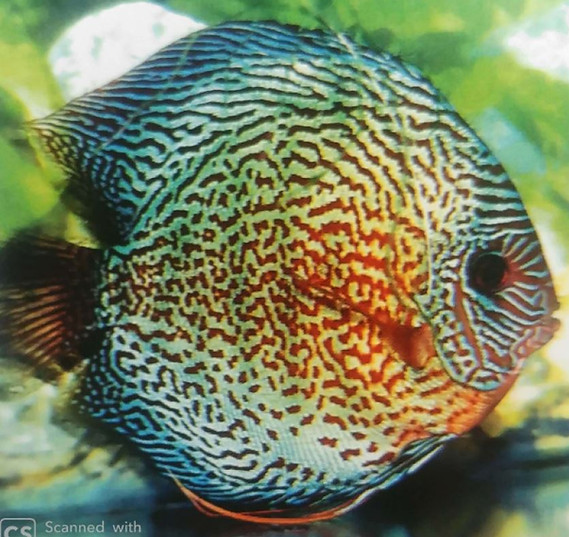
Above: WR37S Super Mosaic Tangerine F2
Above: WR37S Super Mosaic Tangerine F2


Above: WR37S Super Mosaic Tangerine F2
Above: WR37S Super Mosaic Tangerine 2
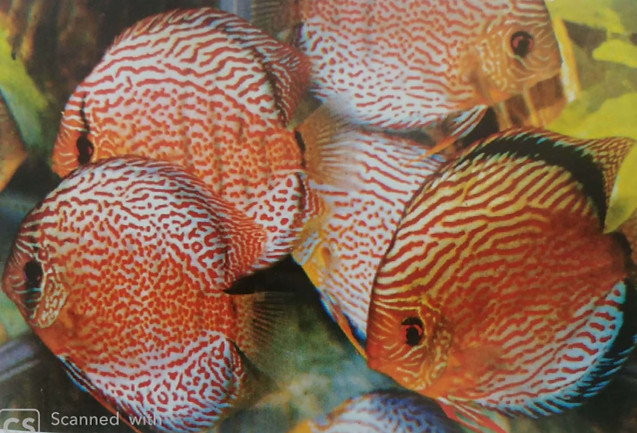
Above: WR37S Super Mosaic Tangerine F2
WR37 Mosaic Tangerine is an excellent bi-product brought about by my many endeavors to improve the inheritance of WR25.
The first WR19LS X WR14RS cross was made in 1992 which I named as WR14N New Red Diamond. The purpose of this hybridization is to establish a second line of WR14RS by breeding a F1 generation WR14RS with a F2 generation WW19LS.
I also mate the F1 generation WR25RS with a F2 generation WW19LS later in the same year so as to study the inheritance of WR25RS and to produce a 2nd line of the strain.
I then cross the above hybrids together in the final effort to ameliorate WR25. The result is the creation of WR37. In the F1 generation, most of the siblings are striped discus but there is one special female possessing a red body and a very good Leopard Skin pattern. Upon inbreeding this female with a brother, specimens with Leopard Skin pattern started to appear. I renamed the strain WR37S Super Mosaic Tangerine.
While WW19LS retains the Green Discus traits even in the later inbred generations, WR37S is quite different from its Green Discus ancestor. It is a true red spotted hybrid strain attaining a bigger size of 15-16 cm. The body form is a lot rounder than WW19LS and they also have longer finnage. A few of the biggest males even have a streamer on the dorsal fin. At least 75% of them have red eyes versus 75% yellow eyes in WW19LS. The black strap on the dorsal, anal fins and the golden abdomen of the Green Discus ancestor have all disappeared. Except for the head and the fringe of the dorsal, anal fins, the rest of the fish is covered by the finest Leopard Skin pattern and in some males, this pattern even extends to the operculum and the proximal 1/5 of the caudal fin.
Considering everything, WR37S Super Mosaic Tangerine is the world's best red spotted hybrid discus strain. It is the ultimate achievement in the red spotted group in the same way that WB22 Blue Diamond is the evolutionary end point in the solid blue category.
WR38 Tomato Red/WR38WS Tomato Red Wide Stripe

Above: WR 38 Tomato Red

Above: WR38WS Tomato Red Wide Stripe, photo courtesy of Mr. Masahiro Kariba, Japan
This is our reddest hybrid discus strain. WR38 was developed from WR14WS. I select the reddest fish to breed in each generation. The result is WR38 Tomato Red which has the same intense red color of a sun ripened tomato. In the first two generations, the turquoise color only occurs as wavy, broken stripes on 1/2-2/3 of the body. Discus with full body striation began to appear in the F3 generation so I changed the name to WR38WS Tomato Red Wide Stripe.
The best WR38WS are more beautiful than their ancestor—Schmidt-Focke Red Turquoise. Besides the larger size of 13-15 cm, the strain has combined the beauty of the Schmidt-Focke Red Turquoise with the Green Discus charm of WW19LS Red Spotted Green Leopard Green. The deep red body is ornate with a sprinkle of tiny red spots and the wide, parallel turquoise stripes. Fins are long and blood red. This strain also has more fishes with red eyes than WR14.
SFR1 Schmidt-Focke Red Turquoise


Above: SFR1 Schmidt-Focke Red Turquoise
Above: SFR1 Schmidt-Focke Red Turquoise

We acquired young adults of the orginal strain from the doctor in 1985-'86 but I was not able to breed them purely.
SFR1 is my attempt to recreate this fabulous strain. In late 1991, I selected specimens of WR14WS having a similar turquoise stripe pattern as broodstocks. After working for eight years, I succeeded to recreate a single fish which is very close to the original strain. It grows to a larger size of 13 cm. This valuable fish also has high fins and wide turquoise stripes from head to tail all over the nicely shaped, deep red body. The proximal part of the dorsal and anal fins are adorned with thick, oblique turquoise stripes. There are no black band on the blood red dorsal and anal fin. In their positions are dozens of very fine, slanted neon blue stripes which extend to the fin edges. The head and operculum are exquisitely decorated with fine turquoise lines. The eyes and the long pelvic fins are deep red. (Photo 162)
I perform a backcross by mating this fish with an excellent WR14WS female to create a second line. There are a lot more fully striated Red Turquoise inside the BC1 hybrid but the turquoise stripes are not as neat and tidy as the father to become wavy and broken in some individuals. Nonetheless, the body, the fins and the eyes are all blood red. Even though I failed to improve the SFR1 strain, I have produced in this BC1 backcross some magnificent Red Turquoise of a bigger size growing to 14-15 cm when matured.
WR1 High Body Red Spotted Green [WW19LS Red Spotted Green Leopard Skin F3 generation X WR29 High Body Red Diamond F2 Generation]
Above: WR1HF High Body Red Spotted Green


This strain is not related to WR1 Red Spotted Brilliant. It was developed in around 1996 by mating WW19LS with WR29. Although very beautiful, it was outshined by our more famous red spotted strains. Very few WR1 was produced and it remains as a rare and insignificant WWFF strain.
WR1HF has inherited the excellent body form and blood red eyes from WR29 but its turquoise stripes are narrower and more wavy than this parental strain. The numerous red spots have merged into small spheres, short bars and narrow, wavy stripes. The dorsal and anal fins are long and are decorated with a wide deep red fringe. The best males also have that patch of gold on the abdomen.
WW41
Rio Paraconi Red Turquoise [S. aequifasciatus Pellegrin, 1904: phenotype brown]
Above: Rio Paraconi Discus parent of WW41 Rio Maderia Red Turquoise
Above: Parents of WW41 Rio Maderia Red Turquoise
This strain was developed by inbreeding a pair of Paraconi Discus having only a few turquoise stripes on the head and the dorsal, anal fins. The two wild fishes have yellow eyes, a reddish brown body color and a weak Heckel Bar. They normally do not show the Heckel Bar but it becomes quite prominent during breeding.
Most of the offspring are striated in the same way as the parents. Only 10% of the F1 generation has turquoise stripes on the whole body and only 3-4% of the brood has yellow eyes. I inbreed the fully striped specimens to obtain a F2 generation that matures as 100% fully striated discus. I gave them the name WW41 Rio Madeira Red Turquoise.
It is a dramatic transformation from the wild ancestors in just two generations of inbreeding and selection. There are about 20% fishes with red eyes in the F2 generation. The best males are high quality Red Turquoise which have also retained the charming wild discus traits to have the lovely golden patch on the abdomen and the head as well as a pair of orange red pelvic fins. Body color is brownish red. There are turquoise stripes all over the whole body and some very fine blue lines on the head and operculum. The black ring on the dorsal and anal fins are not as wide and dark as the wild pair. Both fins are decorated with a deep red fringe and many narrow, oblique turquoise lines.
WW42 Coari (Tefe) Royal Green [S. tarzoo Lyons, 1959: phenotye green]


Above: WW42 Coari (Tefé) Royal Green Female,
photo courtesy of Discus Annual '93-'94, Japan
Above: WW42 Coari (Tefé) Royal Green Male,
photo courtesy of Discus Annal '93-'94, Japan


This strain is developed from a pair of Tefé Red Spotted Green from Werner Konrad. In 1992 Werner decided to concentrate his effort to breed Red Eddie and Alenquer Discus. He was aware we were breeding a lot of Green Discus at that time so our good friend asked Manfred to send us his only pair as a gift.
The male of the pair has wide and linear turquoise stripes at the anterior half of the body. There is also a big solid blotch of turquoise on the abdomen and the proximal 2/3 of the anal fin. The fish has a narrow black band on the dorsal, anal fins and a very long streamer-like extension on the dorsal fin. The female is fully striated with wide but wavy turquoise stripes from head to tail. There is a very wide black band on the dorsal fin and anal fin which is highlighted on the inside by a narrow ring of turquoise. Both parents have many red spots in between the turquoise color. They also have a few dozen short, slanted turquoise lines inside the dark red fringe of the dorsal and anal fin. Needless to say, both fishes have red eyes.
The F1 generation is only average in quality yet there is a major increase in the number of high quality Red Spotted Greens in the F2 generation. A few exceptional specimens have developed very long dorsal and anal fin as well as a huge triangular extension on both of them. In one fish, the dorsal fin and anal fin has grown to such an excessive length that they are actually longer than the caudal fin. A Snakeskin Discus appears in the F3 generation.
There is a story about the naming of the strain—Rio Coari Royal Green—originated from Heiko Bleher; the king of monkey business. In the early 1990s he told German breeders the mother of our WW19LS strain is a Green Discus from the Coari region. Even Manfred was in agreement with Heiko Bleher. He said there were excellent Tefé Green Discus in Germany about 10 years ago. However, when he and other breeders used them for hybridization, all the offspring were Brown Discus. Soon all the German breeders changed the name of their Green Discus from Tefé to Coari. On the contrary, Manaus exporters insist through the years the best Green Discus always comes from the Rio Tefé drainage.
Out of our respect for Werner, I named the strain Rio Coari Royal Green. Rio Tefé Royal Green should be a more appropriate name.
WW47 Brasilian Gold [S. tarzoo Lyons, 1959: phenotype green]
Above: Parent of WW47 Brazilian Gold
Above: Parent of WW47 Brazilian Gold
I was unable to breed the lemon yellow WR14Y Golden Nugget. In 1995 I tried to recreate the variety by inbreeding Green Discus which has a yellowish brown body and minute red spots but free of turquoise color. Nevertheless, I have no success because a lot of turquoise color always appears in the F1 generation. Inbreeding does not help either. Their progeny evolved in exactly the same way as descendants of regular red spotted Green Discus to become solid turquoise discus in the F2 and F3 generations.Similar fishes come from WR19 and WR37 X WR38.
WW49 Wild Red Spotted Green F1


Above: Parent of WW49 Wild Red Spotted Green F1
Above: Parent of WW49 Wild Red Spotted Green F1

Above: Parent of WW49 Wild Red Spotted Green F1

Above: Parent of WW49 Wild Red Spotted Green F1

Above: Parents of WW49 Wild Red Spotted Green F1,
photo courtesy of Mr. Masahiro Kariba, Japan

In 1994 I was lucky enough to purchase a few hundred Green Discus of the best quality in Manaus. According to the exporter Royal Blue, these discus were caught in the Rio Tefé basin. WW49 are the offspring from several best pairs from this batch.
WW49 look very different from their wild parents right from the F1 generation. Their fins become longer and some fishes even have a long streamer on the dorsal and anal fin. The broad black band on the dorsal fin and anal fin of the Green Discus parents becomes more and more narrow as inbreeding proceeds. There is also an enhancement of the turquoise color in each generation. Many of these Green Discus descendants became solid turquoise discus in the F2-F3 generations. The good news is that red spots are always inherited in every generation.
WR1 Red Spotted Brilliant

Above: WR1 Red Spotted Brilliant F2, photo
courtesy of Mr. Masahiro Kariba, Japan
Above: WR1 Red Spotted Brilliant F2, photo
courtesy of Mr. Masahiro, Kariba, Japan


Above: WR1 Red Spotted Brilliant F2, photo
courtesy of Mr. Masahiro Kariba, Japan
Above: WR1 Red Spotted Brilliant F2, photo
courtesy of Mr. Masahiro Kariba, Japan


Mr. Kitano brought to our hatchery an excellent pair of Tefé Royal Green Discus in 1993. Most of the F1 generation offspring have many minute red spots, a lot of turquoise color and red eyes. There are also some some solid turquoise siblings with many blood red spots and the golden abdomen.
The F2 generation attains 12-14 cm when full grown. There is a distinct sexual dimorphism. Most males have an almost solid turquoise body, some red spots, the golden abdomen and a streamer on the dorsal fin. Their dorsal fin, the anal fin is very long and the wide black band in the middle becomes very narrow and inconspicuous. The female sex has a solid turquoise body, short fins, a board black band on the dorsal, anal fins and that charming golden abdomen. The whole fish is decorated with many spots and short bars of deep red. Only the dorsal fin has a narrow, dark red rim which is ornamented with dozens of short and narrow turquoise stripes.
I give them the name WR1 Red Spotted Brilliant with reference to their strong turquoise color and red spots. This strain, especially the males, has become a 85% Brilliant Turquoise in just two generations of inbreeding and selection.
WW46 Flame of the Forest [S. aequifasciatus Pellegrin, 1904: phenotype brown}
Above: Rio Maues Açu Discus, mother of WW46 Flame of the Forest, photo courtesy of Mr. Manfred Göbel, Germany
Above: WW46 Flame of the Forest F1, photo courtesy of Mr. Manfred Göbel,
Germany


Above: WW46H Flame of the Forest Heckel, photo courtesy of "Pitcha-t", Japan
Above: WW46 Flame of the Forest F2


Above: WW46 Flame of the Forest F2 with Red Spots
Above: WW46 Flame of the Forest F2 with Red Spots &
retlculated turquoise stripes
This strain is the offspring of a pair of discus from Rio Maués Açu that we purchased from Royal Blue in October, 1994. The two discus only have a few turquoise stripes on the fins and no trace of the Heckel Bar. They are small but brilliantly red. The male is only 13 cm long and a centimeter less for his mate. The male has a long body form while the female is much rounder and is also redder than the male.
The F1 generation is nearly all solid Red Discus looking like the parents. I gave them the name WW46 Flame of the Forest. There are only two fishes that have a Heckel Bar which I named as WW46H Flame of the Forest Heckel.
The F2 generation is 100% solid red fish. The Heckel Bar has disappeared completely. WW46 has a color intensity deeper than all other wild Red Discus and their offspring. Its red color is a unique combination of deep red plus a very subtle yet noticeable orange tint. When a WW46 is put inside an aquarium together with an Alenquer Discus, the latter appears drab and unattractive. WW46 is even redder than all the reddest Pigeon Blood progeny.
This strain's females are redder than the males. Body form of WW46 is long but it is much better than the original Alenquer Discus. The dorsal, anal and pelvic fins are blood red. There is a wide black strap in the middle of the blood red dorsal and anal fins which is adorned on the inside and outside with a complete or incomplete ring of turquoise color. The majority of this strain only has turquoise stripes on the head, the operculum and fins. Only a minority of the males have additional stripes on the back and abdomen to resemble the striation of a Blue Discus. Most of them have red eyes. WW46 is small like its wild parents to attain only 12-14 cm at maturity.
There are a few special siblings that have some blood red spots inside the deep red body but the most unique specimens are the few possessing a two tone body. The periphery of the whole body and the dorsal, anals fin are a deep red. The center of the body is yellowish brown inside which are many one scale size, blood red spots. The most precious fish has the Leopard Skin pattern on a deep red body which I called WW46SK Flame of the Forest Snakeskin
WW46HF Flame of the Forest High Form


Above: Rio Paraconi Discus Parent of WW46HF
Above: Rio Paraconi Discus Parent of WW46HF

Above: WW46HF Flame of the Forest High Form F2, photo
courtesy of Mr. Fumitoshi Mori, Japan
From the batch of Rio Paraconi Discus that we purchased from Jairo (Royal Blue) in 1994, I selected a few pairs having the reddest color, the roundest body form, the fewest turquoise stripes but without the Heckel Bar for breeding.
The F1 generation grows to 15-16 cm long. They are all solid red discus with a perfectly round body. Females are redder than males. I named them WW46HF Flame of the Forest High Form. In the F2 generation, the excellent round body is also inherited, however, they are still only 50% as red as WW46. The deep red dorsal fin and anal fin is longer than WW46 but the middle black band is not as wide and dark as WW46. Turquoise stripes are restricted to the periphery of the fish. Only the biggest males have additional stripes at the anterior part of the body and a streamer on the dorsal fin. Over 85% of them have red eyes. Not a single discus in both generations has the Heckel Bar.
There are three types of extraordinary discus in the F2 generation. Firstly, some males have a few red spots on the body and a very nice, high body form but without any "Giant Discus Traits". On the other hand, there are also a few red spotted specimens that are carbon copies of Manfred's Giant Discus. Thirdly, there are several high body Red Pearl Discus with all the "Giant Discus Traits" in addition to turquoise spheres and short stripes on the body and dorsal, anal fins.
WW46 and WW46HF are our best Solid Red strains which were derived from wild discus but they are by no means easy to breed. Both strains do not survive inbreeding beyond the F2 generation.
WR52 Regal Tangerine Dream [WR38 Tomato Red Wide Stripe F1 Generation X WR14RS Red Diamond Red Spotted F2 Generation]
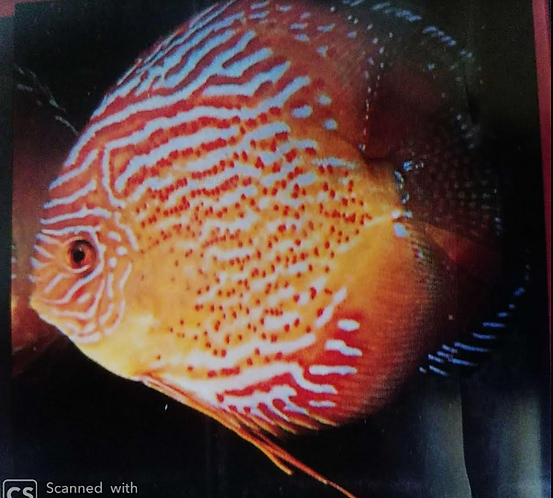
Above: WR52 Regal Tangerine Dream, photo courtesy of "Pitcha-t", Japan
WR52 is a graceful, exotic creation which represents the pinnacle development of a red spotted Red Turquoise. The most attractive feature of the strain is the two tone body color. The back is deep red but the ventral portion of the body is a pleasing light brown. The best specimens also have the golden abdomen. The dorsal, anal fins and the pair of pelvic fins are long and blood red in color. There are vivid turquoise stripes on the whole body and numerous minute red spots in between the stripes. The head and operculum are decorated with fine turquoise stripes. This strain grows to 13-14 cm. Most of them have red eyes.
WR53 Red Spotted Gem [WR37S Super Mosaic Tangerine F2 Generation X WR1 Red Spotted Brilliant F2 Generation]

Above: WR53 Red Spotted Gem, photo
courtesy of Aqua Navi Spring vol. 04, Japan
Like all marvelous strains, WR37S is very difficult to breed even in the F1 generation. The purpose of this hybridization is to establish a second line of WR37S and to revive the strain's fertility which was deteriorating so rapidly in the F2 generation to make them almost impossible to breed. I have achieved my goal in the respect that WR53 is much easier to breed than WR37 but have failed because this strain resembles the female of WR1 Red Spotted Brilliant. It has the oval body form of Green Discus and short fins, however, they do not have the prominent black band on the dorsal and anal fins. The turquoise color is very strong too. Except for the head and abdomen, the whole body and the fins are solid turquoise, which are embellished with many blood red spheres and short, narrow, wavy stripes. There is not much red color on the dorsal and anal fin yet the long pelvic fins are orange red. Some males have the golden abdomen. The strain attains 13-14 cm when full grown and most of them have red eyes.
WR54 Red Diamond Jewel or WR14N New Red Diamond [WW19LS Red Spotted Green Leopard Skin X WR14RS Red Diamond Red Spotted]

Above: WR54 Red Diamond Jewel, photo credit of Mr. Fumitoshi Mori, Japan
In general, its appearance is intermediate between the parental strains. The red spots are smaller than WR14RS but larger than WW19LS. The turquoise stripes are narrower than WR14RS but wider than WW19LS. WR54/WR14N has inherited the elegant light brown body color of WW19LS and some fish even have the graceful golden abdomen. Their fins are long and the orange red pelvic fins are extremely beautiful. The strain has a mixture of red and yellow eyed fish.
While most specimens of this strain grow to 12-14 cm at maturity, there are also a few small, 9-10 cm, magnificent specimens. The whole fish is essentially solid turquoise except for the golden operculum and abdomen. There are many irregularly shaped, 3-4 mm diameter, blood red rings on the periphery of the body and the proximal portion of the dorsal, anal fins. In addition, the fish also has numerous incomplete rings, odd shaped specks and narrow, wavy blood red stripes on the whole body. The deep red fringe of the very long dorsal fin is ornamented with many rather thick, slanted turquoise stripes. The very narrow rim of the anal fin is colorless. The long pelvic fins are orange red. Specimens with a similar color pattern are called "Ring Leopard" by Southeast Asian breeders.
WR55 Mosaic Tomato Red [WR38WS Tomato Red Wide Stripe F1 Generation X WR 29 High Body Red Diamond F2 Generation]
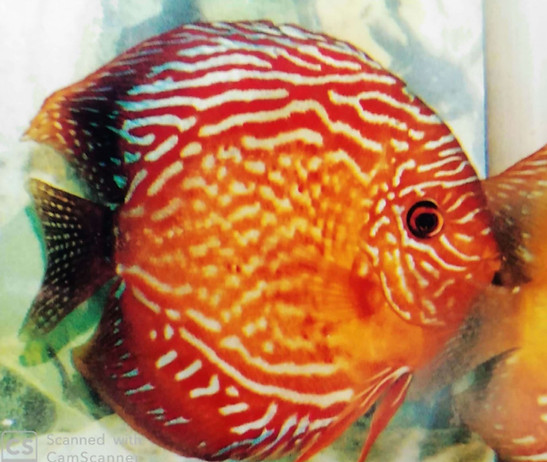
Above WR55 Mosaic Tomato Red, photo courtesy of Mr. Masahiro Kariba, Japan
The inbred WR38WS is a lot more difficult to breed than WR38. To save WR38WS from extinction, I hybridize it with WR29. The resulting WR55 strain has retained most of the deep red body color of WR38 and matures to become 14-15 cm discus. Most of them have red eyes and a round body form. The high dorsal fin and anal fin does not have the middle black ring. Both fins are deep red and are decorated with many oblique turquoise stripes. While most WR55 are either half striped or the turquoise stripes are restricted to the back, abdomen and fins, the best males are fully striated with wide and fluorescent turquoise stripes. They also have numerous red spots and a streamer on the dorsal fin.
WR56 Super Jaguar [WR37S Super Mosaic Tangerine F1 Generation X WR29 High Body Red Diamond F2 Generation]

Above: WR56 Super Jaguar
The goal in making this strain is to create a red spotted strain without the oval Green Discus body form. WR56 can be divided into two types. Firstly, there are some outstanding, 15-16 cm, Red Turquoise. Their bodies are very round and there is also that lovely golden abdomen. The wide but wavy turquoise stripes extend into the dorsal fin and anal fin. The red spots have consolidated into narrow, wavy lines in between the turquoise stripes. The high dorsal and anal fin do not have a black band in the middle. They have a wide deep red fringe which is adorned with many very fine and backward slanting turquoise lines.
The second category shows some resemblance to WR37S. It has the usual oval Green Discus shape growing to only 13-14 cm at maturity. The turquoise stripes are a lot finer and interlaced than the first type. The red spots have merged into spheres and narrow, wavy blood red stripes. The black ring on the dorsal, anal fins are absent in both types of WR56.
WR57 High Body Jaguar [WR 29 High Body Red Diamond F2 Generation X WR38WS Tomato Red Wide Stripe F1 Generation]

Above: WR57 High Body Jaguar
This strain is a refined and deeper red version of WR29. They are big, 16-17 cm discus with a distinct sexual dimorphism. Males have broad turquoise stripes on the whole body extending to the proximal 2/3 of the dorsal fin and anal fin. Both fins do not have a black ring and are decorated with a deep red fringe and oblique turquoise blue lines. The females also have full body striation of wide turquoise stripes terminating at the wide black loop in the middle of the dorsal, anal fins. Inside the narrow but deep red fringe of both fins are many fine, parallel and slanted turquoise lines. The last embellishment of this robust strain is the many deep red stripes, spheres and spots in between the turquoise color. Most of them have red eyes.
WR58 Rio Coari Tangerine [WR37S Super Mosaic Tangerine F1 Generation X WW42 Rio Tefé Royal Green F2 Generation]
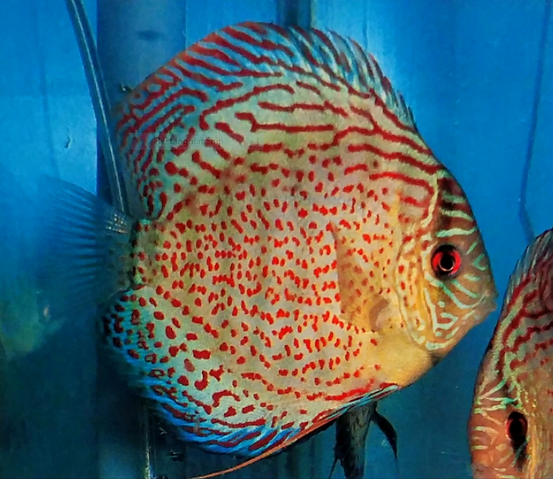
Above: WR58 Rio Coari Tangerine, photo
credit of Mr. Fumtoshi Mori, Japan
This hybridization is another endeavor to save WR37S from extinction. The strain is a good but not exceptional red spotted strain looking intermediate between the parents. The biggest virtue of WR58 is the exceptionally long finnage. The whole body and the proximal part of the dorsal, anal fins are almost solid turquoise which are adorned with numerous blood red spots, speckles and narrow, wavy stripes. There is no conspicuous black band on the dorsal and anal fins. The deep red rim of both fins is adorned with narrow and oblique turquoise blue lines. The pelvic fins are orange red. The strain grows to 13-15 cm. It has a mixture of red- and yellow-eyed discus.
WR59 Giant Red Spotted Green [WR37S Super Mosaic Tangerine F1 Generation X WR19N New Red Spotted Green F2 Generation]

Above: WR59 Giant Red Spotted Green, photo courtesy of Pisces members, Japan
WR59 is a first class red spotted strain and is also one of the biggest to attain 15-17 cm at maturity. In the best males, the body form is very round but even so, most of the females still have the oval Green Discus shape. Their dorsal and anal fins are very long and also do not have any trace of the black band which are ornamented by a deep red fringe and many narrow, oblique, neon blue stripes. The turquoise stripes in both sexes are a little bit thicker and less convoluted than WR37S. In between the turquoise color are red spheres, specks and narrow, wavy stripes that are made up of many overlapping red spots. Most of them have yellow eyes.
WR60 Giant Mosaic Tangerine [WR37S Super Mosaic Tangerine F1 Generation X WR25WS Tangerine Dream Wide Stripe F2 Generation] X [3/419LS Red Spotted Green Leopard Skin X WR25RS Tangerine Dream Red Spotted F2 Generation] (

Above: WR60 Giant Mosaic Tangerine
This complex hybrid is an improved, bigger version of WR37S attaining 15-17 cm when fully grown. The body of WR60 is very round but without 'Giant Discus Traits". The largest males develop a long, narrow, triangle extension on the dorsal fin. It is a vigorous strain with good fertility. If it was created earlier so that I had enough time to improve the strain, WR60 should be able to replace WR37S as WWFF's best red spotted hybrid. But that is life!
WR62 Zebra Red Turquoise [WR29 High Body Red Diamond F3 Generation X WR1HF High Body Red Spotted Brilliant F2 Generation]
It is a beautiful creation during the sunset period of my discus career. The strain has a round to high reddish brown body and high fins. It has wide turquoise blue stripes from head to tail. The dorsal fin and anal fin is deep red which is decorated with a very narrow black ring in the middle. Inside the blood red rim of both fins are a dozen thin and oblique turquoise lines. The final embellishment is the pair of deep red pelvic fins. WR62 grows to 15-17 cm. All have blood red eyes.
WR63 Red Hercules [WR16 High Body Red Turquoise F3 Generation X WR36 Red Peony F2 Generation]
They have a round, brownish red body color and wide, parallel stripes. It is a big strain. The males reach 16-18 cm when full grown.

